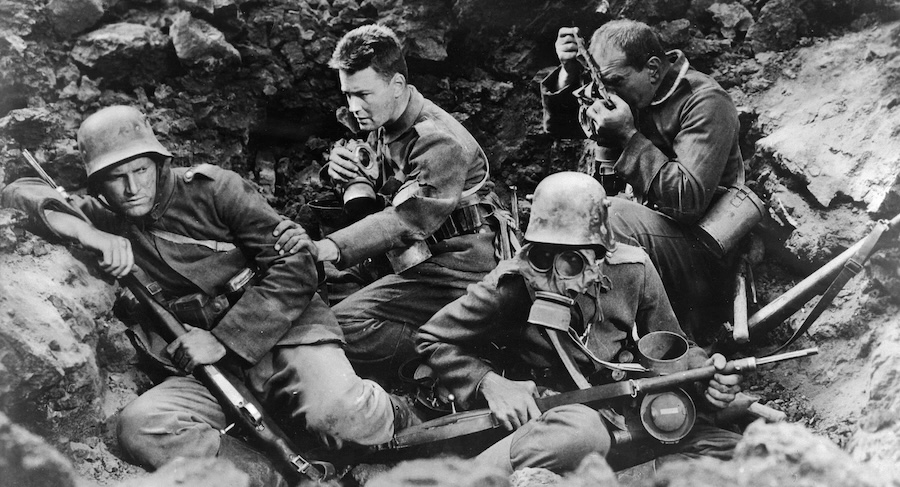
AT LAST… THE MOTION PICTURE!

The first talkie to win a Best Picture Oscar portrays the Great War nine years before it would have its even more devastating round two. When the film premiered in Germany, three years before Adolf Hitler rose to power, Nazis (led by Joseph Goebbels) disrupted screenings, outraged that the film would show German troops fearing the slaughter rather than cheering it on. Book burnings were arranged where Erich Maria Remarque’s novel was a target.
Producer Carl Laemmle, Jr. did his best to convince Germany of the film’s artistic value, even agreeing to cuts that ruined much of its impact. In the end, he realized the true horrors of the Nazi regime, especially for his Jewish friends, and would go on to help hundreds of them to safety.
Sacrificing for the Fatherland
After the outbreak of World War I, a school teacher preaches to his class of teenage boys the value of fighting for your country, of sacrificing for the Fatherland. Many of the boys are inspired to enlist in the army, among them Paul Bäumer (Lew Ayres). After training, the fresh troops are transported to the Western Front, the bloody trenches where a life of barbed wire, machine gun nests and heavy artillery bombardment awaits. There, Paul and his comrades get to know Stanislaus Katczinsky (Louis Wolheim), a veteran who teaches them the tricks of survival in the trenches. Paul gets to experience both traditional warfare in the shape of hand-to-hand combat, but also the new horrors of this era, planes that carry bombs and the startling efficiency of machine guns…
Exposing the lies of war propaganda
Remarque was himself a veteran of World War I, the kind of German the Nazis would end up loathing. He knew what it meant to go to war and used his landmark novel to expose the lies of war propaganda, vividly represented in this adaptation by Paul’s fanatical teacher and a memorable scene where older men in his home town act like armchair generals, arguing over territories and ignoring the real costs of war.
The film was criticized in Poland at the time for being “pro-German” but its message of peace transcends borders.
The final scene, a hand reaching for a butterfly in the trenches, has become part of cinema history, an unforgettable symbol of a desperate desire for peace. The film was criticized in Poland at the time for being “pro-German” but its message of peace transcends borders. It is sometimes easy to forget that this is a Hollywood film. The battle scenes, recreated in California, with actual veterans as extras, show a vast landscape devastated by bombs and artillery fire. Cinematographer Arthur Edeson’s camera brings it all to life, along with editor Edgar Adams, who show the terror from all angles, sometimes in ways that would be unthinkable after the enforcement of the Hays Code in 1934. We’re talking lost limbs and blood here.
This is technically speaking superior filmmaking. At other times, it’s easy to think of it as a Hollywood film; the cast rarely distinguishes itself, especially in the eyes of modern audiences, I’m sure, and brings a classically American sentimentality to the film. Most characters remain largely shallow, even though the political and emotional themes of Remarque’s book resonate.
Paul Bäumer is easily relatable and his journey from gung-ho to jaded antiwar veteran has been echoed through every war since. I was last reminded of that fact when I saw Oliver Stone’s Born on the Fourth of July (1989) again. It’s always easier to be anti-war when it concerns the ones that should have been avoided, like World War I and Vietnam. It’s telling that 100 years later we fear another Great War. The Iraq War was easily avoidable… but it still happened only 11 years ago.
All Quiet on the Western Front 1930-U.S. 133 min. B/W. Produced by Carl Laemmle, Jr. Directed by Lewis Milestone. Screenplay: George Abbott, Maxwell Anderson, Lewis Milestone, Del Andrews. Novel: Erich Maria Remarque. Cinematography: Arthur Edeson. Editing: Edgar Adams. Cast: Lew Ayres (Paul Bäumer), Louis Wolheim (Stanislaus Katczinsky), John Wray (Himmelstoss), Slim Summerville, Russell Gleason, Ben Alexander.
Trivia: The film has been shown in many different cuts, but this version is the official restored one, released in 1998; the original version was roughly ten minutes longer. Zasu Pitts was originally cast as Ayres’s mother. Remade as a TV movie in 1979, and in Germany as All Quiet on the Western Front (2022). Followed by The Road Back (1937).
Oscars: Best Picture, Director.
Last word: “When first released, the film was exactly the way I wanted it… All Quiet had rough sledding in many countries and in some was forbidden exhibition. But I’m glad to report that the picture proved to have a longer life than many a politician and is still going strong in spite of brutal cutting, stupid censors and bigoted politicos.” (Milestone, “Filming ‘All Quiet on the Western Front’”)
